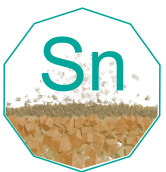Tin

Tin (Sn)
General Information
- Symbol: Sn
- Atomic Number: 50
- Atomic Weight: 118.710 u
- Element Category: Post-transition metal
- Group: 14
- Period: 5
- Block: p-block
Physical Properties
- Appearance: Silvery-white metallic
- Density: 7.265 g/cm³
- Melting Point: 231.93 °C (449.47 °F)
- Boiling Point: 2602 °C (4716 °F)
- Phase at STP: Solid
- Electron Configuration: [Kr] 4d¹⁰ 5s² 5p²
- Oxidation States: +4 (most common), +2
Chemical Properties
- Reactivity: Tin is resistant to corrosion and oxidation in air and water, making it a useful material for coatings.
- Compounds: Forms compounds such as tin(II) chloride (SnCl₂), tin(IV) oxide (SnO₂), and stannous fluoride (SnF₂).
Uses and Applications
- Soldering: Widely used in solder for joining metal parts, especially in electronics.
- Coatings: Used to coat other metals to prevent corrosion, such as in tin cans for food preservation.
- Alloys: Used in alloys like bronze (tin and copper) and pewter (tin, antimony, and copper).
- Glass Production: Tin oxide is used in making glass, including the float glass process for windows.
- Chemistry: Used in various chemical reactions and compounds for stabilizers in PVC plastics and other materials.
Occurrence and Extraction
- Natural Occurrence: Found primarily in the mineral cassiterite (SnO₂).
- Extraction: Extracted by mining cassiterite, then smelting to produce tin metal.
Isotopes
- Stable Isotopes: Tin has ten stable isotopes, the most of any element, including Tin-112, Tin-114, Tin-115, Tin-116, Tin-117, Tin-118, Tin-119, Tin-120, Tin-122, and Tin-124.
- Radioactive Isotopes: Tin-126 is a notable radioactive isotope used in scientific research.
Safety and Handling
- Hazards: Tin itself is not highly toxic, but some tin compounds can be toxic if inhaled or ingested.
- Precautions: Handle tin compounds with care, using appropriate protective equipment to avoid exposure.
History
- Discovery: Known since ancient times, tin has been used for over 3,500 years.
- Name Origin: The name “tin” is derived from the Old English word “tin,” and its symbol “Sn” comes from the Latin word “stannum.”
Additional Facts
- Crystal Structure: Tetragonal (β-tin) at room temperature, cubic (α-tin) below 13.2°C
- Magnetic Properties: Diamagnetic
- Thermal Conductivity: Moderate, about 66.6 W/m·K
- Electrical Resistivity: About 115 nΩ·m at room temperature
Summary
Tin is a versatile post-transition metal with significant applications in soldering, coatings, and alloy production. It is resistant to corrosion and oxidation, making it valuable for coating other metals and preserving food in cans. Found primarily in the mineral cassiterite, tin is extracted through mining and smelting. Its stable isotopes and historical significance further highlight its importance in various industries.
40 Question and Answer Pairs About Tin
What is the atomic number of Tin?
- 50
What is the symbol for Tin?
- Sn
What is the atomic weight of Tin?
- 118.710 u
In which group of the periodic table is Tin found?
- Group 14
What period is Tin in?
- Period 5
What block does Tin belong to?
- p-block
What is the melting point of Tin?
- 231.93 °C (449.47 °F)
What is the boiling point of Tin?
- 2602 °C (4716 °F)
What is the density of Tin?
- 7.265 g/cm³
What is the electron configuration of Tin?
- [Kr] 4d¹⁰ 5s² 5p²
What are the common oxidation states of Tin?
- +4, +2
What is the appearance of Tin?
- Silvery-white metallic
Is Tin reactive with air?
- Tin is resistant to corrosion and oxidation in air.
Name a compound of Tin.
- Tin(IV) oxide (SnO₂)
What is a common use of Tin in soldering?
- Used in solder for joining metal parts in electronics
How is Tin used in coatings?
- To coat other metals to prevent corrosion, such as in tin cans
What role does Tin play in alloys?
- Used in alloys like bronze and pewter
How is Tin used in glass production?
- Tin oxide is used in making glass, including the float glass process
What application does Tin have in chemistry?
- Used as stabilizers in PVC plastics and other materials
Name a mineral that contains Tin.
- Cassiterite (SnO₂)
How is Tin extracted from ores?
- By mining cassiterite and smelting
What is the most stable isotope of Tin?
- Tin-120
Name a notable radioactive isotope of Tin.
- Tin-126
What safety hazard is associated with Tin compounds?
- Some tin compounds can be toxic if inhaled or ingested
How long has Tin been known to humans?
- For over 3,500 years
Where does the name Tin come from?
- Derived from the Old English word “tin”
What is the crystal structure of Tin at room temperature?
- Tetragonal (β-tin)
Is Tin paramagnetic or diamagnetic?
- Diamagnetic
What is the thermal conductivity of Tin?
- About 66.6 W/m·K
What is the electrical resistivity of Tin at room temperature?
- About 115 nΩ·m
What is the primary oxidation state of Tin?
- +4
Is Tin found as a free element in nature?
- No, it is found in ores like cassiterite
What is the common name of tin(II) chloride?
- Stannous chloride
What is a major application of stannous fluoride (SnF₂)?
- Used in toothpaste to prevent cavities
How does Tin benefit solder?
- Provides a low melting point and good wetting properties
What is the boiling point of Tin in Kelvin?
- 2875 K
What group does Tin belong to in the periodic table?
- Post-transition metals
What is the natural abundance of Tin-120?
- About 32.59%
Can Tin be used in high-temperature applications?
- Yes, in specific alloys and coatings
What is the key property that makes Tin valuable in coatings?
- Its resistance to corrosion and oxidation.






